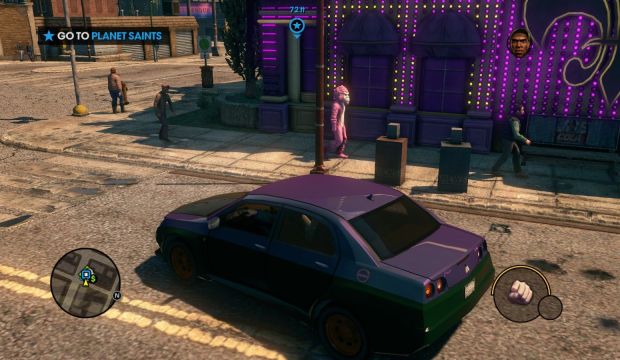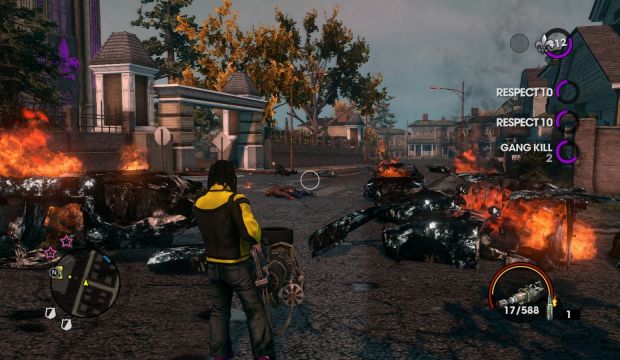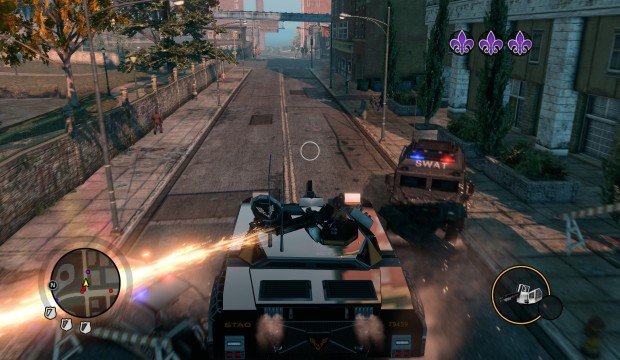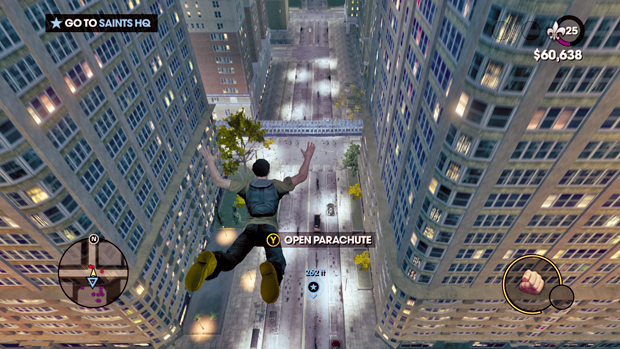RePlayed: Saints Row: The Third
Once upon a time, video games were designed to be one thing, and one thing only: fun. Before they were developed to be modern “art”, before it really mattered if they turned a million dollar profit, before people cared about photorealistic visuals or franchise power, games were created to pass the time, to make us smile, to bring us together. These days, the concept of fun is something that seems to be factored in late during a game’s development, or sometimes not at all, at least in the case of big AAA franchises. Developers think nothing of actually tempering the fun with long moments of, well, “non-fun”, in order to pad out a game’s run-time or show off their flashy new engine.
Take Assassin’s Creed III, as an easy example. Playing as the highly-skilled, lethally-trained Haytham Kenway throughout the opening several hours has its moments, sure, but they’re interspersed with too much talking, too much walking, during which Ubisoft get to show off all the cool things their Anvil Next engine can do and “immerse” the player in what feels very much like a real three-month sea journey. It’s slick, well-made and well-executed – but is it actually fun? For a series fan, maybe. For me, not so much, no.
Even Naughty Dog’s The Last of Us (currently vying with one or two other titles for my personal GOTY award) can’t be considered “fun” for a good portion of its run-time, given how harrowing it is and the emotion it often forces upon the player. It’s a brilliant game, yes, and some of the set-pieces are exceptionally enjoyable, but it’s not really what you would describe as “fun”.

HOLIER THAN THOU: Not so long ago, if you wanted big budget, grown-up enjoyment, there was only one franchise worth visiting: Grand Theft Auto. After the success of GTA III and Vice City, Rockstar took out a big fat crock-pot and stirred in carjacking, gunfights, ultra violence, risqué characters, bad language and unapologetic racial stereotyping to produce Grand Theft Auto: San Andreas, a gangsta-themed analogy of South Central LA that not only showed a different side of GTA but cemented Rockstar as the Kings of social parody, the Masters of the OTT. It was a crown that no one thought would ever be contested. With try-hards like True Crime falling flat, Rockstar’s franchise was the only ride in the park if you wanted to set off a rocket launcher in the carpool lane or execute pedestrians just for walking too close to your awesomeness.
And then, in 2006, several years after San Andreas and a few years before Grand Theft Auto decided it wanted to be social commentary rather than the irreverent fun it always used to be, Illinois-based developers Volition, Inc. burst onto the scene with Saints Row, a wilfully over-the-top action game that took everything we loved about San Andreas and dialled it up about eight notches. It had its detractors, of course, including its fair share of haters who wanted to write it off as nothing but an inferior copy of Rockstar’s game. In many ways, such claims were justified – but only until Saints Row 2 followed GTAIV out of the gate. It was at that point that their paths truly diverged.
By the time Saints Row: The Third hit the shelves, it was a clone no more. Derided no more. Hated on, no more. If Saints Row 2 was a cry for recognition and acceptance, a sincere plea to be seen as not only its own beast, but also its own master, then Saints Row: The Third was a heartfelt “fuck you” to anyone who refused to give it the credit it knew it deserved. As GTA moved further and further away from the insane and experimented with social analogies and family drama, Saints Row went the opposite way, experimenting with mankinis and death-by-dildo.

WELCOME TO STEELPORT: Saints Row: The Third begins with a bank heist in the series’ original setting of Stilwater, as the Boss (that’s you), right-hand-man Johnny Gat and the sassy, over-enthusiatic Shaundi raid the vault dressed in over-sized Gat heads along with an actor there to “learn from the best”. Predictably, it goes wrong, and we’re treated to one of the craziest opening set-pieces ever as the Boss hangs from the side of the vault – which has been torn out of its cradle by helicopter winch – and fights off an army of armoured cops.
Such is the popularity of the Saints following the Boss’s defeat of the Ultor Corporation in the previous game, that the S.W.A.T team attempting to apprehend them are more interested in getting their guns signed and landing a date with Shaundi than stopping the robbery. As an introduction to the world of Saints Row: The Third, it’s faultless. It’s the entire ethos of the series crammed into a ridiculously enjoyable fifteen minutes, yet when the next set-piece is even more off the wall and over the top, well, that’s when you know you’re in for a real treat.
Not content with stealing a bank vault with a helicopter, the Boss then engages in a mid-air shootout aboard the private jet of Philippe Lauren, leader of the Syndicate, a triumvirate of mega-gangs who control the city of Steelport and are muscling in on the Saints’ home-city of Stilwater. With Gat sacrificing himself to save him (or her), the only logical thing for the Boss to do is immediately put himself in even greater danger by smashing through the plane’s windscreen, indulging in a gunfight as he literally flies through the cargo hold, before blasting out of the back end and skydiving like a pro to catch Shaundi and parachute them both to safety. Yes, this really happens. And it’s absolutely brilliant.

CREWED UP: So, you’ve robbed a bank, escaped custody, seen your best friend die to save you and effectively started a war with a conglomerate of highly-equipped, highly-trained, incredibly wealthy rival gangs – what do you do next? If you’re a 3rd Street Saint, you get tooled up, tanked up and crewed up, that’s what. The tutorial is hidden under the pretext of scoping Steelport, visiting the Saints-owned clothing store to buy some new threads, hitting the local military base to acquire some weaponry, buying your first store and indulging in one instance of every side-activity available on the extensive map.
Your chaperone during this early period is Pierce Washington, public relations extraordinaire and all-round nice guy with a gun who fills Gat’s considerable shoes as the Boss’s new confidante. Unlike Gat, Pierce doesn’t take things so seriously; he enjoys the attention, the fame, the acclaim, and the doors opened by all three. He aims to wrest the streets of Steelport from the Syndicate’s control, but he wants the Saints to look good while doing it. Relationships like the one shared by the Boss and Pierce are at the heart of Saints Row’s narrative and always were. If anything exists within the framework of mid-air hijacks, city-wide manure-spraying and physics-defying set-pieces to ground the franchise at all in the real world, it’s human interaction.
The Boss is tough, ruthless and focused, but he/she needs the support network of characters like Shaundi and Pierce. Similarly to Mass Effect’s Shepard, the Boss seems, to me, to play better as a woman. As a female, the rock-hard veneer is almost impenetrable, but hides a sensitivity conveyed in the voice acting (particularly Laura Bailey’s vocal contribution) that doesn’t exist when played as male. It’s not an inherent weakness – far from it – but it humanises the character far more, makes her less of a caricature and more of a person. This is never more apparent than during the Boss’s first drive with Pierce, when a song comes on the radio that reminds them of a simpler time and they sing along to it as you drive around.
There’s something sweet and endearing about the camaraderie that highlights their friendship and makes you care, and when the Boss is played as female there’s something almost stirring in it: they are equals, their relationship not muddled by awkwardly-written flirtations or clumsy innuendo. Even FemShep can be taken all the way to having sex with her crewmates, male or female, but the Boss is different. As a woman, she’s powerful and dominant, yet relies on her friends, male or female, to help her through the tough times. I’m not pretending for a moment that Saints Row: The Third doesn’t objectify both sexes to an extensive degree, because it does, but the character of the Boss is not among the offending articles (only the player can opt to slap a mankini over a double-E cup bust; the game never forces that).
TOYZ IN THE HOOD: Regardless of this, being angry with Saints Row: The Third over claims of misogyny or misandry is pointless, perhaps even petty. You may as well complain that it “glorifies crime” and promotes racial stereotyping. Yes, it does, if you’re the kind of person who is influenced by such things and not simply a normal individual who accepts that it’s just game that’s set in a very silly world, itself a parody of our own. Saints Row 3 is deliberately in-your-face, unapologetically so, and still manages to be less offensive than a lot of other titles out there.
Most of the fun stems from its intentional and exaggerated irreverence. Steelport is not merely a sandbox; it’s an outright playground – and one that is not meant to be examined, analysed or studied, or ever juxtaposed with the real world. Stealing cars is wrong, shooting pedestrians is wrong, gang warfare is wrong – we all know that. Saints Row: The Third paints a picture of such things and colours it with comical physical laws, action straight from an 80’s blockbuster and as much crazy as it can manage while still maintaining a coherent narrative.
It lets you base jump off your penthouse balcony when you can’t be arsed to take the lift down, lets you have a complete plastic surgery makeover for $500 or rob a military installation like you’re ram-raiding a jeweller’s. You can take part in a game show wherein you have to kill ridiculously-dressed mascots, or steal a manure truck and paint the town brown. If you really want to rock the boat, you can even do a story mission now and then. I remember getting bored time and again while playing Grand Theft Auto IV and having to resort to going postal with a rocket launcher to pass the tedium. Not so in Saints Row: The Third, because the story missions are just as bonkers as the side missions, and just as insane as when you go out for a drive just to see what trouble you can get into. Factor in the mental DLC that includes all sorts from aliens to superheroes, and you’ll begin to feel that Saints Row: The Third has a pathological hatred of boredom.

3RD STREET FOREVER: There’s a definite sense of “you against the world” in Saints Row 3. When you’re not dodging the helpfully colour-coded rival gangs or the police, you’ll be set upon by STAG, the elite, anti-gang government hit-squad who take over in the second half as the main antagonists. And yet, you’ll still find time to take in the sights and generally dick around.
As a game world, Steelport isn’t quite as refined or well-oiled as Niko Bellic’s Liberty City, but it works. The persistently changing world is always on the move, whether you’re watching a couple of pedestrians tear chunks out of each other, or witnessing a street crime in progress and the police response. But no matter what you’re up against, or what goes on around you, Steelport always remains your city. You’re the boss. You don’t give a fuck what people say or think about you; you don’t care how many goons the other gangs send after you, or how many times you get shot, run over or thrown out of an exploding helicopter. Steelport is yours.
Which, of course, is Saints Row: The Third’s greatest triumph. It is truly open. You can leave the story right where it is for hours if you choose, while you throw yourself into traffic for the insurance money, or go for a spin in a chopper with nothing but a sniper rifle and a smile. Though it may flit between immaturity, inanity and insanity, one thing Saints Row: The Third always remains, is fun. As Saints Row 4 prepares to crank up the crazy even further, there’s never been a better time to revisit Steelport and give it another damn good kicking.
It’s good to be the Boss.




